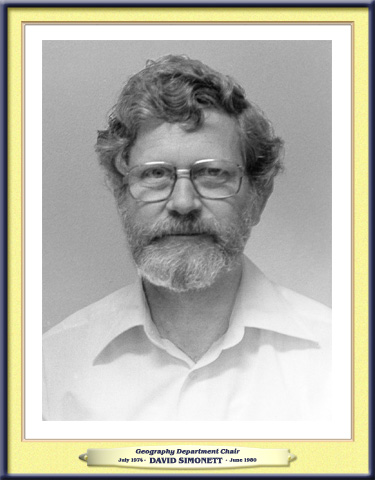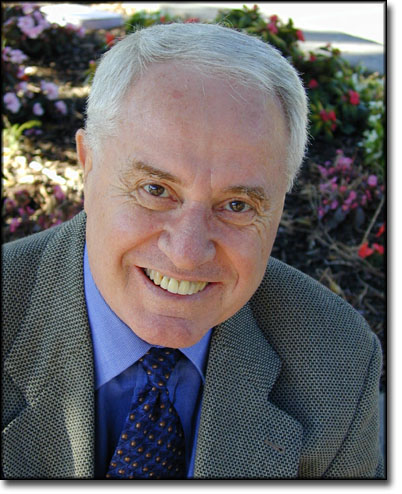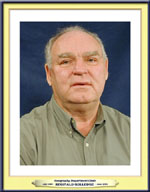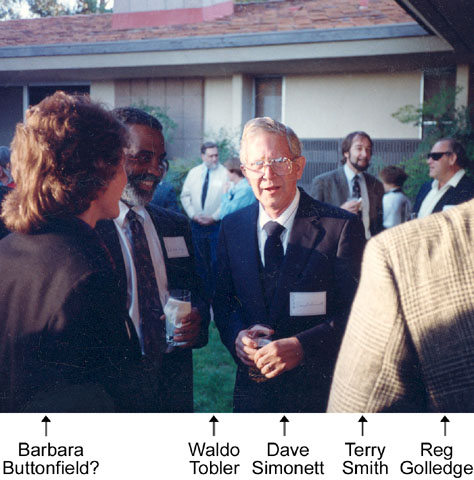Geography began as a “program” at UCSB under the direction of the Dean of College of Letters and Science in 1963, and by 1964, the program had two full-time instructors and offered five classes. A Geography major was established in February 1966, and its first BA was granted in June, but Geography didn’t become an autonomous department until 1974. The following is a description of those turbulent days, taken from an article titled “The Department of Geography at the University of California, Santa Barbara: History, Curriculum, and Pedagogy” by Keith Clarke and Susanna Baumgart (Yearbook of the Association of Pacific Coast Geographers, Volume 66, 2004):
In 1973, a change in deanship altered the role of Geography significantly. Chemistry professor Bruce Rickborn became associate dean of the College of Letters and Science. Acknowledgment was made that the geography program to date had been poorly run by the administration. At the time Rickborn became dean, Geography had six faculty positions, one of which was unoccupied. Some members of the academic senate not only vied for the vacant faculty slot, but advocated terminating Geography. Rickborn had to decide whether Geography would have a future at UCSB. He assembled a committee of three extramural geographers who spent 6 to 8 months researching the study of Geography, reading articles, and listening to geographers.
Rickborn concluded, “Eighty-five percent of Geography departments were moribund.… ‘This tribe occupies this area, and this is what they grow and eat.’” Geography as an extension of grammar school curriculum was not going to fly at UCSB. However, Rickborn respected the kind of geography that [Jack] Estes was doing, reassuring Estes that “We could build something based on remote sensing.” Rickborn had to convince the vice chancellor of the viability of a modern, technological geography department, and also had to address the opposition to geography in the academic senate. To ensure greater likelihood of the future chair being able to create the department Rickborn envisioned, he thought it best to reinvent the current program. “I had the unfortunate job of telling all except Estes that they had to leave.” So, in the early 1970s, UCSB Geography died, the sole surviving spark carried on by Estes’ work on aerial photography and remote sensing. This period is colloquially referred to as the “night of the long knives.”
A chair search committee sought a professor with demonstrated stature who was committed to a remote-sensing emphasis. The short list of candidates included David Simonett, Reginald Golledge, and Harm de Blij, all highly respected geographers. In an interview, Rickborn stated “Originally, I thought zero of social geography—until I met Reg.” The economics professor on the search committee also knew of work in economic geography, and also respected Golledge. Nevertheless, the committee chose Simonett.
Simonett had long wanted to build a forward-looking, progressive geography department featuring a well-funded remote-sensing research center. The seeds of this interest were evident early in his studies. In the 1940s, while a student at the University of Sydney (Australia), he was introduced to land use mapping. The first person to graduate from any Australian university with a PhD in geography, Simonett had focused his doctoral research on applying scientific methods to land use mapping. He worked at the University of Sydney, the University of Maryland, and the University of Nottingham before finally joining the Department of Geography at the University of Kansas, where he remained for 15 years. All the while, he was developing expertise in remote sensing. In 1966, he was appointed associate director of the University of Kansas Remote Sensing Laboratory. In 1970, he returned to the University of Sydney, hoping to contribute to his alma mater. Compared to the research funding he had come to expect in the United States, Australia’s funding seemed insufficient to build the kind of program in remote sensing that he sought. Consequently, in 1972, Simonett became director of the Washington-based Earth Satellite Corporation, where he was working when he learned of the opening for a founding chair of Geography at UCSB. “Although at last a senior scientist in a large remote sensing establishment, David retained his dream of one day developing his own research institution with a University environment,” wrote Trevor Langford-Smith (1991).
Simonett was hired and took over as the first chair of the new department when it came into formal existence on July 1, 1974. As soon as Simonett was hired, he began pursuing Golledge, someone he knew had been a rival candidate for chair. Simonett’s strategy for building a department was to carve out portions of geography, both human and physical, that were connected by the common use of measurement and analysis. The goal was to seek accomplished people for each focal area, then to infill with junior faculty. Golledge was seen as key to one of the areas that would become UCSB’s strength, human behavioral geography. Simonett was an aggressive recruiter, even making personal trips to persuade senior hires to come. Among the early recruits were Golledge, Waldo Tobler, and Terry Smith. During the 1970s and 1980s, Simonett followed a consistent hiring strategy based on clusters of faculty with reinforcing interests, jump started with initial senior hires. This strategy attracted to UCSB a group of young, energetic scholars that he not only personally tutored in grantsmanship, but also encouraged, pressured, and steered closely through academic promotion and tenure. Among these was Jeffrey Dozier, who stated, “A lot of the credit has to go to Simonett. We thrived because of two of Simonett’s characteristics. One, he talked to everybody. In other words, he kept everyone up to date on what everybody else was doing; he helped professors cross-pollinate. And two, he had the least contentious ego. He took genuine pleasure in others’ achievements; he didn’t need to take credit.”
In 1980, Simonett made his last hire as chair: Richard Church, a young assistant professor, to bolster human geography. Simonett then stepped down as chair. With fewer duties, he was prevailed upon to take over the role of dean of Graduate Studies at UCSB in 1981, although he still remained highly active in the department; he died in 1990. Golledge became the second chair.
Editor’s note: Simonett was notorious for his lack of patience (as were Estes and Golledge!), as well as for his “Simonettisms,” some of which include: “I don’t care how you get here! Come on the smell of an oily rag!” (Simonett’s reply to Terry Smith when Terry asked how he should get to UCSB); “Tell them Simonett’s hopping mad”; “You’ve got to make a commitment, God damn it!”; “blood fatid dingo kidneys”; and “If you apply a clustering algorithm, then, by God, you will get — clusters!!”





